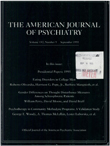Failure to find evidence for linkage or association between the dopamine D3 receptor gene and schizophrenia
Abstract
OBJECTIVE: This study was performed to assess the possible involvement of the dopamine D3 receptor gene (DRD3) in the etiology of schizophrenia. The authors' approach included a population study and a family study using both parametric (lod score) and nonparametric (affected pedigree member) methods of linkage analysis. METHOD: Two different DNA markers were studied at the DRD3 locus. The family study included 35 multiplex families of schizophrenic subjects for the linkage analyses. The population study involved 50 unrelated schizophrenic subjects and 50 normal comparison subjects from the same ethnic and geographic origin. RESULTS: Whichever clinical classification was used to define the pathological phenotype (schizophrenia or schizophrenia spectrum), the results of the lod score and affected pedigree member studies did not provide any evidence of linkage of the DRD3 gene to the illness. The negative results of the association study reinforce these results. CONCLUSIONS: The hypothesis that the DRD3 gene has a predisposing role in schizophrenia was not supported by these population and family studies. However, the possibility that this gene has a role in the etiology of the disease cannot be definitely excluded because of the intrinsic limitations of the methods of analysis and the number of subjects studied.
Access content
To read the fulltext, please use one of the options below to sign in or purchase access.- Personal login
- Institutional Login
- Sign in via OpenAthens
- Register for access
-
Please login/register if you wish to pair your device and check access availability.
Not a subscriber?
PsychiatryOnline subscription options offer access to the DSM-5 library, books, journals, CME, and patient resources. This all-in-one virtual library provides psychiatrists and mental health professionals with key resources for diagnosis, treatment, research, and professional development.
Need more help? PsychiatryOnline Customer Service may be reached by emailing [email protected] or by calling 800-368-5777 (in the U.S.) or 703-907-7322 (outside the U.S.).



